|
Symbols of both positive and negative effects of technologyThe top register, both in the center and the side panels has been seen as a kind of secular Last Judgment. The west wall in European churches/chapels (see the Sistine Chapel, for example) sometimes depicted the Last Judgment with Christ in the center raising up the blessed on his right--the viewer's left and condemning the evil to hell--on the viewer's the right. The destructive use of aviation (the war planes and gas masks) is indicated on the upper left. |
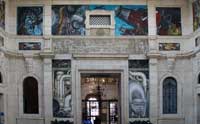
|
| |
|

|
"Aviation" with fighter planes on the right and passenger planes on the leftAccording to Linda Bank Downs, the Ford Motor Company sold fighter planes to various countries in the late 1920s and early 1930s and Rivera might have observed the building of these planes (80). The commercial transport plane on the left is the Ford Tri-Motor. The ominous quality of the fighter planes is underlined by the soldier with the gas mask. |
| |
|
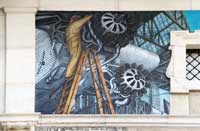
|
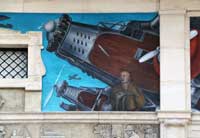
|
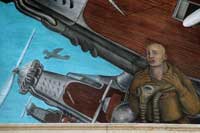
|
| |
|
Top register, side panelsThese panels essentially continue the scene in the central top panel with the bodies of the planes extending into the side panels. The peaceful dove is in the small panel on the left whereas the rapacious hawk is on the right. |

|

|
| |
|
Middle register: "Interdependence of North and South"This long monochromatic panel, designed to look like a bas-relief, depicts another aspect of Detroit industry--the Ford Motor Company freighters delivering raw materials to the port at Rouge Michigan (with the skyline of Detroit in the background). On the right, men work on a rubber tree plantation collecting sap to make latex for tires; Ford had established such a plantation in Brazil. This panel sets up the connection between the agrarian south and the industrialized north with the waterway also representing the interconnectedness. On the left side, Rivera depicts "a pipe-fitter (left) and man working a chain pulley (right) . . . in front of a bridge crane on railroad tracks used to unload freighters" (Downs 85). Mexican symbolism--a half face and half skull on either side of the star--emphasizes the coexistence of life and death.
|
 |
The interdependence is also seen symbolically through the compass above the rectangular panel which points to both the northeast and southwest. |
| |
|
The lowest register: "Steam" and "Electricity" with a worker in the former (left side) and an engineer in the latter (right side)The manager portrait is a composite of Henry Ford and Thomas Edison. |
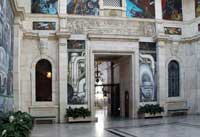
|
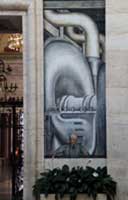
|
Downs points out that Rivera altered the actual appearance of the turbine (on the "Electricity" side) to resemble an ear, perhaps as a way of underlining the supervision the managers exercised over the workers (88-89). (See also the South Wall where a stern manager supervises the work.) |
| |
|
Accurate rendering of steam units in the Powerhouse at RougeThe worker is connected with the physical power of steam. Both worker and manager are associated with kinds of power. |

|

|


 Click here to return to index of art historical sites.
Click here to return to index of art historical sites.
 Click here to return to index of artists and architects.
Click here to return to index of artists and architects.
 Click here to return to chronological index.
Click here to return to chronological index.
 Click here to see the home page of Bluffton College.
Click here to see the home page of Bluffton College.

